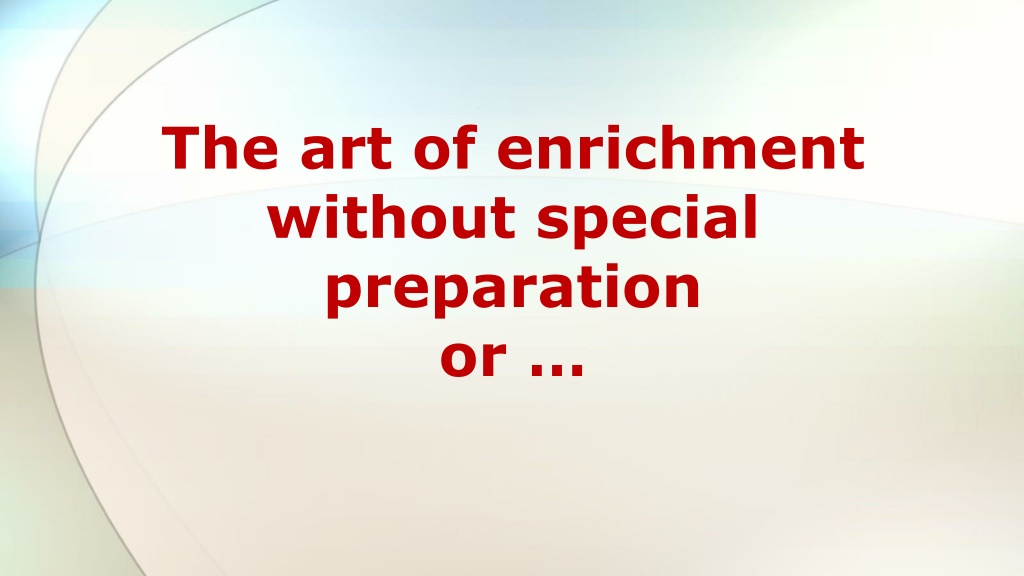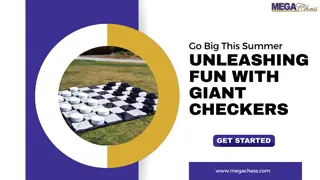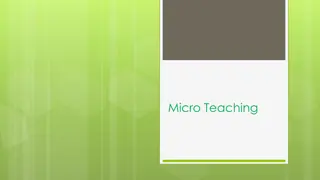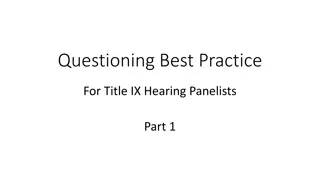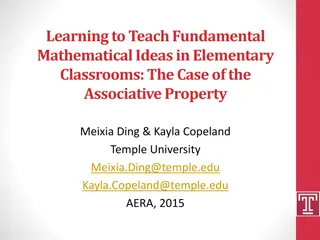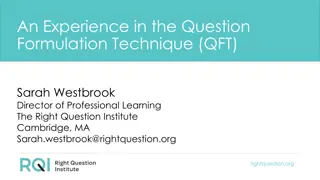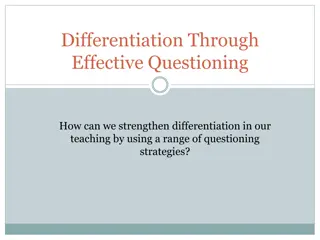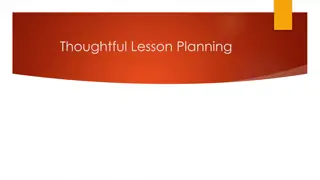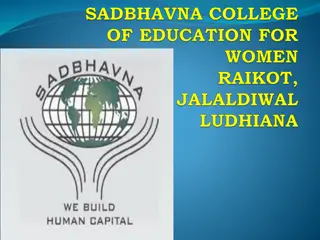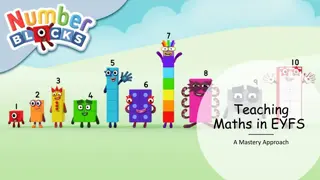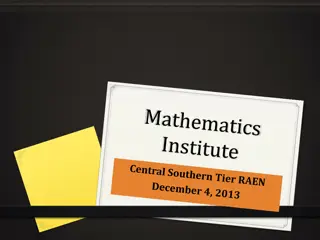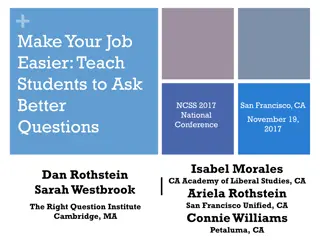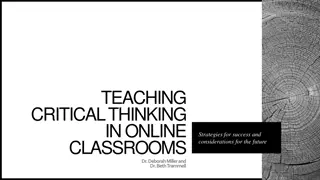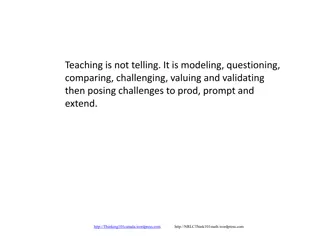Unleashing the Extraordinary in Questioning Through Thoughtful Mathematics Teaching
Explore the art of enriching ordinary questions, turning them into extraordinary learning experiences. Join Narcisa Corcaci from Werribee Secondary College as she shares insights on transforming questions into opportunities for critical and creative thinking in mathematics education. Discover the power of worded questions, challenges, and strategies like explicit teaching, collaborative learning, and differentiated instruction. Dive into the world of tackling worded questions to enhance student comprehension and problem-solving skills.
Download Presentation

Please find below an Image/Link to download the presentation.
The content on the website is provided AS IS for your information and personal use only. It may not be sold, licensed, or shared on other websites without obtaining consent from the author. Download presentation by click this link. If you encounter any issues during the download, it is possible that the publisher has removed the file from their server.
E N D
Presentation Transcript
The art of enrichment without special preparation or
How to turn an ordinary question into an . extraordinary one Don t get me wrong here most questions are meaningful already the way they are. I just want to show my students that there are questions behind answers.
Presenter : Narcisa Corcaci Head of Mathematics Werribee Secondary College corcaci.narcisa.n@edumail.vic.gov.au
Solving a maths problem is like eating a piece of cake. You can gobble it up or you can enjoy every bit of it. and while I do that I also use some HITS, namely: 3 - Explicit teaching; 4 - Worked examples; 5 - Collaborative learning; 6 - Multiple exposure; 7 - Questioning; 9 - Metacognitive strategies; 10 Differentiated teaching;
As a teacher I need a good challenge as much as my students do. My own challenge in this case is to exploit any opportunity of challenging my students. Worded questions constitute such a great resource.
Tackling worded questions represents a very important step in understanding. developing students When questions in class explicit support is given to students towards developing their critical and creative thinking capabilities. discussing and solving worded Therefore I regard solving worded questions as an important component of my teaching. I incorporate them in my teaching as often as possible once new skills are explicitly taught.
The context: 1. Most questions are like little riddles Therefore in order to solve a question, we have to understand it first. 2. Understanding takes time ( as we enjoy every bit of it !) If we do spend the time to understand the question, why not turn it into something extraordinary?
How? Under the same context 1. Choosing different values or harder expressions. 2. Extending the set of allowable values (for example from N to Z, from Z to Q or from Q to R). 3. Changing some of the conditions (you may add conditions or get rid of some) 4. Generalising if possible. 5. Asking students to scaffold / simplify / organise / categorise.
How? Using new context, derived from the original question, by: 6.Asking students to write their own question. 7. Asking students to critique questions created by their peers (look for unnecessary information, incomplete details given, questions that are impossible to solve, unclear context etc.). 8. Asking students to create a template for a solution to a type of question. These examples are just a few of the many possibilities.
Moving towards the top levels of Bloom s Taxonomy Related image
Moving towards the end of SOLOs Taxonomy
Question 1 Year 7 Fractions Operations with fractions + and - Original question (from memory): There is 1 L of juice in a bottle. James drinks ? afternoon. What fraction (of the original amount) is left? ?L in the morning and ? ?L in the
Solution: Most students will get that: ? ? ?? After drinking ? ? ?L of juice in the afternoon there is ?? in the bottle so the fraction left is ?? ? ? ?= ?? ? ? = ?? ?? ?L of juice in the morning and ??L left ??.
At this stage I am not sure if my students understood the difference between fractions and quantities. I could have asked for units for their calculation but instead I make ..
1st Change: What if the original amount of juice was 2L? Students start calculating: 2 ? How is that for an answer? After drinking ? juice there is ?? is ?? ? ? ? = ?? ? ? = ?? ?? ?? ? L of juice and another ? ? L of ?? L left in the bottle so the fraction left ?? (worded answer).
In this new context, does the answer make sense? Giving students one minute to write down in their books one reason why ?? allows me to evaluate their understanding. Some students may need to read the question again while others to write the original quantity as a fraction. However most students are able to recognise that ?? bigger than 1. ?? is wrong ?? is
One student explains: But ? ?? of 2L and ? ? ? L represents ?? of 2L so the fraction left is 1 - = ?? and another one says: ? ? L is actually 200mL and ? 125mL so there is 2000 200 125 = 1675 mL left out of 2000mL which means ???? ? L represents ? ?? ? ?? = ?? ? ? ? ?? ?? ?L is actually ???? = ?? ??
What about my solution? (Not that is needed any more) Out of 2 L, James already had ? and there is ?? means ?? ? L + ? ? L = ?? ?? L out of 2 L ?? L ?? L left in the bottle. ?? ?? ? =?? ?? (half).
2nd or 3rd or 4thchange What if the original amount of juice was 5L? Or 10L? Or n L? or .5 L? By the way .is this possible? What is the minimum amount of juice possible in the bottle, that makes this question valid? (I already see a function, an expression and domain .but they are just in year 7, aren t they?)
I also often encourage students to: Place these new related questions posed into categories: easy, medium and hard. Think of other questions that could be answered Change a different question following similar ways Try some of the questions written by peers for homework etc. Creating a new question by modifying the original question is a skill that must be modelled by teacher. I set similar tasks as homework only once, as a class, we made sufficient attempts for students to feel challenged but not overwhelmed by writing (and solving) their own questions. My aim is to assist students become more curious and inquisitive.
Question 2- Year 7 Fractions Revision Original question (from memory) James got a cake for his birthday. He ate half of it that day and, every day after that, half of what was left from the previous day. What fraction has he eaten after 4th day? If James continues to eat from his cake following this pattern, when will he be finishing the cake?
Solution: (I helped here with the setting out) After Fraction Fraction day eaten left 1 ? 2 ? 3 ? 4 ? ? 1 ? ? + ? ? + ? ? + ? ? = ? ? = ? ? = ? ?? = ? ? ? = ? ? + ? ? + ? ? 1 ? ? = ? ? + ? ? ? ? 1 ? ?? = ?? ?? 1 -?? ??
Answer: After 4th day James has eaten ?? and has ? He will never finish the cake as there is always some cake left in the fridge since he is eating only half (theoretically). ?? of his cake ?? of the cake left. I definitely cannot let this opportunity slip away
So . I ask What is the fraction left after 5th day? By now everyone knows what to do: ? ? + ? ? + ? ? + ? ?? + ? ??= ?? ?? ?? = ? ?? 1 - ?? What is the fraction left after 6th day? No trick question here: ? ? + ? How can I stop here when I am so close .? ? + ? ? + ? ?? + ? ?? + ? ??= ?? ?? ?? = ? ?? 1 - ??
My next question was What is the fraction left after nth day?
They look for a pattern: After 1 day ? ? After 2 days ? After 3 days ? After 4 days ? After 5 days ? After 6 days ? ? ? ?? ?? ??
How are these numbers related: 2,4,8,16,32 ? Powers of 2 : ??,??,??,??,?? and ?? . What if we have n in the first column? Therefore ?? After a few minutes, great class and group discussions and some unsuccessful attempts students figured out the correct answer. ? ??
We actually managed to write the line for the n-th step: ? ? + ? 1 - ?? Conclusion : After ??? day there is still ? cake left (theoretically). ??= ?? ? ? + ? ?? ? ?? = ? ? + ? ?? + ? ??+ .. + ? ?? and ?? of the Have I pushed too far at the end of the day , they are only in year 7? Maybe . but it was worth it
Question 3 Year 7 A snail slithers 2 mm every 5 seconds. How long will it take to slither 1 m? (just a matter of finding how many 2mm are in 1 m).
Some changes: 1. A snail slithers 2 mm every 5 seconds. How long will it take to slither 0.5 km? 2. A snail slithers 2 m every 3 hours. How long will it take to slither 5 mm? 3. A snail slithers 3 mm every 8 seconds. How long will it take to slither 1 m? 4. A snail slithers 2 mm every 5 seconds. After slithering for 5 seconds it stops for 4 seconds. How long will it take to slither 1 m?
Some more changes: 5. A snail slithers 2 mm every 5 seconds while a second one slithers 2 m in 5 hours at a constant rate. Which one is faster? 6. A snail slithers 2 m in 5 hours at a constant rate. A second snail follows the path of the first one 10 minutes later. They meet each other after another 30 minutes. What is the constant rate at which the second snail slithers?
Ask students to: A. Place these new related questions posed into categories: easy, medium and hard. B. Think of other questions that could be answered; maybe harder C. Change a different question following similar ways D. Write their own related questions E. Provide feedback to questions written by peers etc.
Year 9 Surds 1 Students have learnt the binomial formula (? ?)?=?? ??? + ?? ; however, very few of them were using it and I did not like that. Using or not using that formula does not make much difference time wise (for students) when calculating ( ? + ? ?)? for example; why then bother? It will matter though when calculating ( ? + ? ?)? and that was the sort of challenge I chose for them.
Why not trying: (? + ?)?= ??+ ???? + ????+ ??? So I started with something they knew . or they could easily grasp .Pascal s triangle and showed them how the formula works. 1 1 1 2 1 1 3 3 1 1 4 6 4 1 1 5 10 10 5 1 etc
(? + ?)?=???+ ??? (? + ?)?=???+ ?????+ ??? (? + ?)?= 1??+ ?????+ ?????+ ??? (? + ?)?= ???+ ?????+ ?????+ ?????+ ??? (? + ?)?= ???+ ?????+ ??????+ ??????+ ?????+ ??? etc We discussed how these formulae can be proved. Checked for (? + ?)? ;if they did not believe me that it was a shortcut worth learning, they still had the option to use their long way .
My students learnt that they could gain speed when shortcuts are used (and that is exactly what mathematicians do). We went back to Pascal s triangle many times that year. Even though not all my students were able to use the formula: (? + ?)?= ??+ ???? + ????+ ?? most of them could confidently use (? ?)?=?? ??? + ??
Year 9 Surds 2 From definition to much more I asked my year 9 students to write down the properties (laws) of surds. To my surprise first one was : ? is always a positive number. This is great maths I thought to myself they continued with all other rules : ( ?)?= ?; ??= ?; ? ? = ??; ? ? ? ? =
Ok, I say, then: According to the second one ( ?)?= -2? No, some students said, because -2 (the answer) is not positive. I just followed the second rule; that was all I did. Or the rule is wrong? The rule is wrong Or maybe just incomplete? Incomplete .they agreed .a,b 0. This is way I do not allow my students to cancel like that: ( ?)?
But that is not the end of the story I asked them to calculate ? + ? if ? = ?. One student says: But there is no rule for ? + ? ! That is interesting .I thought to myself
Firstly, my student was using the rules . Secondly, my student knew the rules and recognised that there wasn t one he could apply here. Those were signs of great maths
In this context, the fact that he was overcomplicating himself became minor, in my opinion. I wanted him to understand why there is no rule for that. So my next question for him was:
What sort of rule are you thinking about? Something along the line: ? + ? = ? + ?
Lets see what happens if I raise both sides to the power of 2: ( ? + ?)?= ( ? + ?)? ? + ? = ? + ? ?? + ? Is this true? It does not look right. Then? Look at the question again. It is just a simple substitution: ? + ?= ? + ?=3 and ? + ? ?? + ? = ? + ? ; ?,? ?
Year 9 Linear equations Two 10 cm candles are lit in the same time. One candle burns out in 4 hours. The other candle burns out in 5 hours. If both candles burn at a constant rate, how long it takes for one candle to be twice as high as the other one? You must write and solve a linear equation in order to find the answer.
Possible prompts: Read the question and explain it to your partner (with your book closed). Draw a picture. Identify the candle that will be twice as long as the other one (second one in this case). Identify the unknown for our equation: t = time (in number of minutes) taken for the second candle to become twice as long as the first one . Emphasis on units. Working given in context (and the answer).
Solution: Picture drawn t= time in min when second candle is twice the size of the first At the start After t minutes
In mathematical terms Height (cm) time (minutes) 10 .. 240 h1 .. t ?? = ???= candle after t minutes) The height of the first candle after t minutes is : 10 - ?? Similarly: ?? minutes ??? ? ?? (the height burnt off from the first ? ? ?? is the height of the second candle after t
The equation ?? From where we find t= 200 minutes ? ? ?? = 2 (10 - ??) Answer: After 200 minutes the second candle is twice as high as the first one.
And now lets make some changes Solve this question using a different method (graphing, trial and error, algorithms come to mind). Write your own question similar to the one given (candles having same length but different burning times). Identify the piece of information that is not necessary in the original question. How can you make it more difficult? (choosing candles of different lengths for example). Without giving the lengths of the candles, write a question that can be solved with two original candles having different lengths (that type of question seemed to challenge the most my students).
